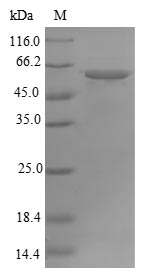인류의 건강과 생명공학 발전을 위해 봉사하는 기업 드림셀
We Serving the Health and Biotechnology of Humanity
We Serving the Health and Biotechnology of Humanity

제품코드 : CSB-EP002344HU
제품정보 : Metabolism
| Description | This Recombinant Human ATP5F1A protein was made through genetic engineering. By putting the ATP5F1A gene into the genetic material of E.coli cell, the E.coli could be used as factories or producers to make the desired ATP5F1A protein for research uses. The expression region of this protein is at 44-553aa. N-terminal 6xHis tag was used in the expression process. The purity is 90%+ determined by SDS-PAGE. ATP synthase F1 subunit alpha (ATP5F1A), a complex V protein, was the most frequently affected subunit, in 10% of tumors and 11% of benign prostate tissues (but not both tissues in any single p...Read more |
| Purity | Greater than 90% as determined by SDS-PAGE. |
| Target Names | ATP5F1A |
| Uniprot No. | P25705 |
| Research Area | Metabolism |
| Alternative Names | ATP synthase alpha chain; ATP synthase alpha chain; mitochondrial; ATP synthase subunit alpha; ATP synthase subunit alpha mitochondrial; ATP synthase; H+ transporting; mitochondrial F1 complex; alpha subunit 1; cardiac muscle; ATP synthase; H+ transporting; mitochondrial F1 complex; alpha subunit; 1; ATP synthase; H+ transporting; mitochondrial F1 complex; alpha subunit; isoform 1; cardiac muscle; ATP synthase; H+ transporting; mitochondrial F1 complex; alpha subunit; isoform 2; non-cardiac muscle-like 2; ATP sythase (F1 ATPase) alpha subunit; ATP5A; Atp5a1; ATP5AL2; ATPA_HUMAN; ATPM; Epididymis secretory sperm binding protein Li 123m; hATP1; HEL-S-123m; MC5DN4; mitochondrial; Mitochondrial ATP synthetase; Mitochondrial ATP synthetase oligomycin resistant; Modifier of Min 2; Modifier of Min 2 mouse homolog; Modifier of Min 2; mouse; homolog of; MOM2; OMR; ORM; OTTHUMP00000163475 |
| Species | Homo sapiens (Human) |
| Source | E.coli |
| Expression Region | 44-553aa |
| Target Protein Sequence | QKTGTAEMSSILEERILGADTSVDLEETGRVLSIGDGIARVHGLRNVQAEEMVEFSSGLKGMSLNLEPDNVGVVVFGNDKLIKEGDIVKRTGAIVDVPVGEELLGRVVDALGNAIDGKGPIGSKTRRRVGLKAPGIIPRISVREPMQTGIKAVDSLVPIGRGQRELIIGDRQTGKTSIAIDTIINQKRFNDGSDEKKKLYCIYVAIGQKRSTVAQLVKRLTDADAMKYTIVVSATASDAAPLQYLAPYSGCSMGEYFRDNGKHALIIYDDLSKQAVAYRQMSLLLRRPPGREAYPGDVFYLHSRLLERAAKMNDAFGGGSLTALPVIETQAGDVSAYIPTNVISITDGQIFLETELFYKGIRPAINVGLSVSRVGSAAQTRAMKQVAGTMKLELAQYREVAAFAQFGSDLDAATQQLLSRGVRLTELLKQGQYSPMAIEEQVAVIYAGVRGYLDKLEPSKITKFENAFLSHVVSQHQALLGTIRADGKISEQSDAKLKEIVTNFLAGFEA Note: The complete sequence including tag sequence, target protein sequence and linker sequence could be provided upon request. |
| Mol. Weight | 59.2kDa |
| Protein Length | Full Length of Mature Protein |
| Tag Info | N-terminal 6xHis-tagged |
| Form | Liquid or Lyophilized powder Note: We will preferentially ship the format that we have in stock, however, if you have any special requirement for the format, please remark your requirement when placing the order, we will prepare according to your demand. |
| Buffer | If the delivery form is liquid, the default storage buffer is Tris/PBS-based buffer, 5%-50% glycerol. Note: If you have any special requirement for the glycerol content, please remark when you place the order. If the delivery form is lyophilized powder, the buffer before lyophilization is Tris/PBS-based buffer, 6% Trehalose, pH 8.0. |
| Reconstitution | We recommend that this vial be briefly centrifuged prior to opening to bring the contents to the bottom. Please reconstitute protein in deionized sterile water to a concentration of 0.1-1.0 mg/mL.We recommend to add 5-50% of glycerol (final concentration) and aliquot for long-term storage at -20°C/-80°C. Our default final concentration of glycerol is 50%. Customers could use it as reference. |
| Troubleshooting and FAQs | Protein FAQs |
| Storage Condition | Store at -20°C/-80°C upon receipt, aliquoting is necessary for mutiple use. Avoid repeated freeze-thaw cycles. |
| Shelf Life | The shelf life is related to many factors, storage state, buffer ingredients, storage temperature and the stability of the protein itself. Generally, the shelf life of liquid form is 6 months at -20°C/-80°C. The shelf life of lyophilized form is 12 months at -20°C/-80°C. |
| Lead Time | 3-7 business days |
| Notes | Repeated freezing and thawing is not recommended. Store working aliquots at 4°C for up to one week. |
| Datasheet & COA | Please contact us to get it. |